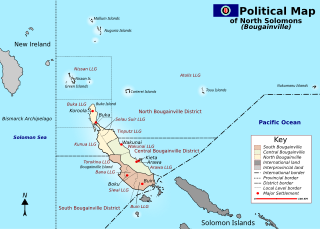
Bougainville, officially the Autonomous Region of Bougainville, is an autonomous region in Papua New Guinea. The largest island is Bougainville Island, while the region also includes Buka Island and a number of outlying islands and atolls. The current capital is Buka, situated on Buka Island.

Bougainville, an autonomous region of Papua New Guinea (PNG), has been inhabited by humans for at least 29,000 years, according to artefacts found in Kilu Cave on Buka Island. The region is named after Bougainville Island, the largest island of the Solomon Islands archipelago, but also contains a number of smaller islands.
Bougainville Independence Movement (BIM) was a political party in the Autonomous Region of Bougainville, of eastern Papua New Guinea.
New Bougainville Party (NBP) is a political party in the Autonomous Region of Bougainville in Papua New Guinea.
Joseph Canisius Kabui was a secessionist leader and the first President of the Autonomous Region of Bougainville, off the coast of Papua New Guinea, from 2005 to 2008. He was also the leader of the Bougainville People's Congress.
John Tabinaman was the Acting President of the Autonomous Region of Bougainville, in Papua New Guinea, from 7 June 2008 to 6 January 2009.

The President of the Autonomous Region of Bougainville governs the island, which is an autonomous entity within Papua New Guinea.

Presidential elections were held in Bougainville from November 30 to December 18, 2008. Voters elected the new President of the Autonomous Region of Bougainville, following the death of President Joseph Kabui while in office, on June 7.

James Tanis is a politician in Papua New Guinea who was elected President of the Autonomous Region of Bougainville in 2008 following the death of Joseph Kabui while in office, serving the remainder of the term from 2009 to 2010. He was previously the Vice President of the Bougainville People's Congress.
Sam Akoitai was politician from Papua New Guinea. A member of the United Resources Party, he served in several ministerial roles and ran for president of the country.
Ezekiel Massat is a Bougainvillean lawyer and politician. Massat was appointed the Vice President of the Autonomous Region of Bougainville by President James Tanis on January 19, 2009. Bougainville is an autonomous region within Papua New Guinea.

Presidential and parliamentary elections were held in the Autonomous Region of Bougainville in Papua New Guinea from 6 to 21 May 2010.

John Momis is a Bougainvillean politician who served as the President of the Autonomous Region of Bougainville in Papua New Guinea between 2010 and 2020.
Patrick Nisira is a Bougainvillean politician. He was Vice President of the Autonomous Region of Bougainville under President John Momis from 10 June 2010 to 22 February 2017. He was reappointed as vice president by Ishmael Toroama on 25 September 2020.

The Bougainville conflict, also known as the Bougainville Civil War, was a multi-layered armed conflict fought from 1988 to 1998 in the North Solomons Province of Papua New Guinea (PNG) between PNG and the secessionist forces of the Bougainville Revolutionary Army (BRA), and between the BRA and other armed groups on Bougainville. The conflict was described by Bougainvillean President John Momis as the largest conflict in Oceania since the end of World War II in 1945, with an estimated 15,000–20,000 Bougainvilleans dead, although lower estimates place the toll at around 1,000–2,000.
A presidential and parliamentary election was held in the Autonomous Region of Bougainville between 11 May and 25 May 2015.

A presidential and parliamentary election was held in the Autonomous Region of Bougainville between 12 August and 1 September 2020. 440 candidates were contesting the 40 seats in the Bougainville House of Representatives, including 25 competing to be President of the Autonomous Region of Bougainville. The new government will negotiate the outcome of the 2019 Bougainvillean independence referendum, which saw 98.3% of voters supporting independence from Papua New Guinea.
Ishmael Toroama is a Bougainvillean politician who was elected President of the Autonomous Region of Bougainville in 2020. He is a former commander in the Bougainville Revolutionary Army.
Magdalene Toroansi is a Papua New Guinean diplomat and politician. She is from the Autonomous Region of Bougainville, and was Minister for Women from 2005 and 2008. In 2010 and in 2020 she ran as a candidate for President of the Autonomous Region of Bougainville, but was unsuccessful on both occasions.

Bougainville is an autonomous region in Papua New Guinea. At regional level, Bougainville elects a President and a House of Representatives. A non-binding independence referendum was held in 2019. In this referendum, 98% of voters voted in favour of independence.





